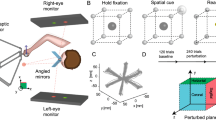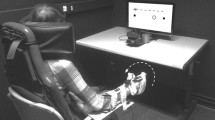Summary
The aim of the present study was to investigate the processes underlying aiming movements (motor programming and feedback control), and to explore their modification through learning. Two groups of 6- and 9-year-old children were asked to perform a directional aiming task without visual feedback (open-loop situation). After 15 trials (pretest) all subjects were submitted to a practice session which consisted of three series of trials with visual feedback (closed-loop situation). Half of the subjects had to perform the task at maximum speed (programmed movements), while the other half was required to perform slow movements (feedback-controlled movements). After the practice session all subjects were tested again in the openloop situation without time constraints (posttest). The results showed that during the practice session, accuracy was greater than in the two test conditions. It was greater in the case of slow movements than in the case of rapid ones. Moreover, in the case of rapid movements, it did not improve over the three practice series, while it did improve with slow movements. The difference between pre- and posttests showed that both groups improved their accuracy with practice in all conditions, the greatest improvement being obtained with rapid practice movements in 9-year-old children. It is suggested that different types of feedback (on-line and delayed feedback) contribute in varying degrees to the improvement of the aiming movements. However, the rapid movement condition, which requires a greater efficiency of programming, was found to be more effective for learning than the slow movement condition. The age-related differences found in learning suggest that feedback information can be fully integrated into motor programming only after 6 years of age.
Similar content being viewed by others
References
Bard, C. & Hay, L. (1983). Etude ontogénétique de la coordination visuo-manuelle. Journal Canadien de Psychologie, 37 390–412.
Bard, C., Paillard, J., Bellec, J. & Fleury, M. (1982). Eye-head coordination for directional control of projecting aiming movement in children. Psychology of Motor Behavior & Sport (North American Society for the Psychology of Sport and Physical Activity), 140.
Beggs, W.D.A. & Howarth, C.I. (1972). The movement of the hand towards a target. Quarterly Journal of Experimental Psychology, 24 448–453.
Hay, L. (1979). Spatial-temporal analysis of movements in children: motor programs versus feedback in the development of reaching. Journal of Motor Behavior, 11 189–200.
Hay, L. (1981). The effect of amplitude and accuracy requirements on movement time in children. Journal of Motor Behavior, 13 177–186.
Hay, L. (1984). Discontinuity in the development of motor control in children. In: W. Prinz & A.F. Sanders (Eds.), Cognition and Motor Processes. Berlin—Heidelberg-New York: Springer-Verlag.
Hofsten, C. von (1979). Development of visually directed reaching: the approach phase. Journal of Human Movement Studies, 5 160–178.
Hofsten, C. von (1980). Predictive reaching for moving objects by human infants. Journal of Experimental Child Psychology, 30 369–382.
Keele, S.W. & Posner, M.I. (1968). Processing of visual feedback in rapid movements. Journal of Experimental Psychology, 77 155–158.
Schellekens, J.M.H., Karlverboer, A.F. & Scholten, C.A. (in press). The micro-structure of tapping movements in children. Journal of Motor Behavior.
Sugden, D.A. (1980). Movement speed in children. Journal of Motor Behavior, 12 125–132.
Author information
Authors and Affiliations
Rights and permissions
About this article
Cite this article
Hay, L., Bard, C. The role of movement speed in learning a visuo-manual coordination in children. Psychol. Res 46, 177–186 (1984). https://doi.org/10.1007/BF00308602
Issue Date:
DOI: https://doi.org/10.1007/BF00308602




